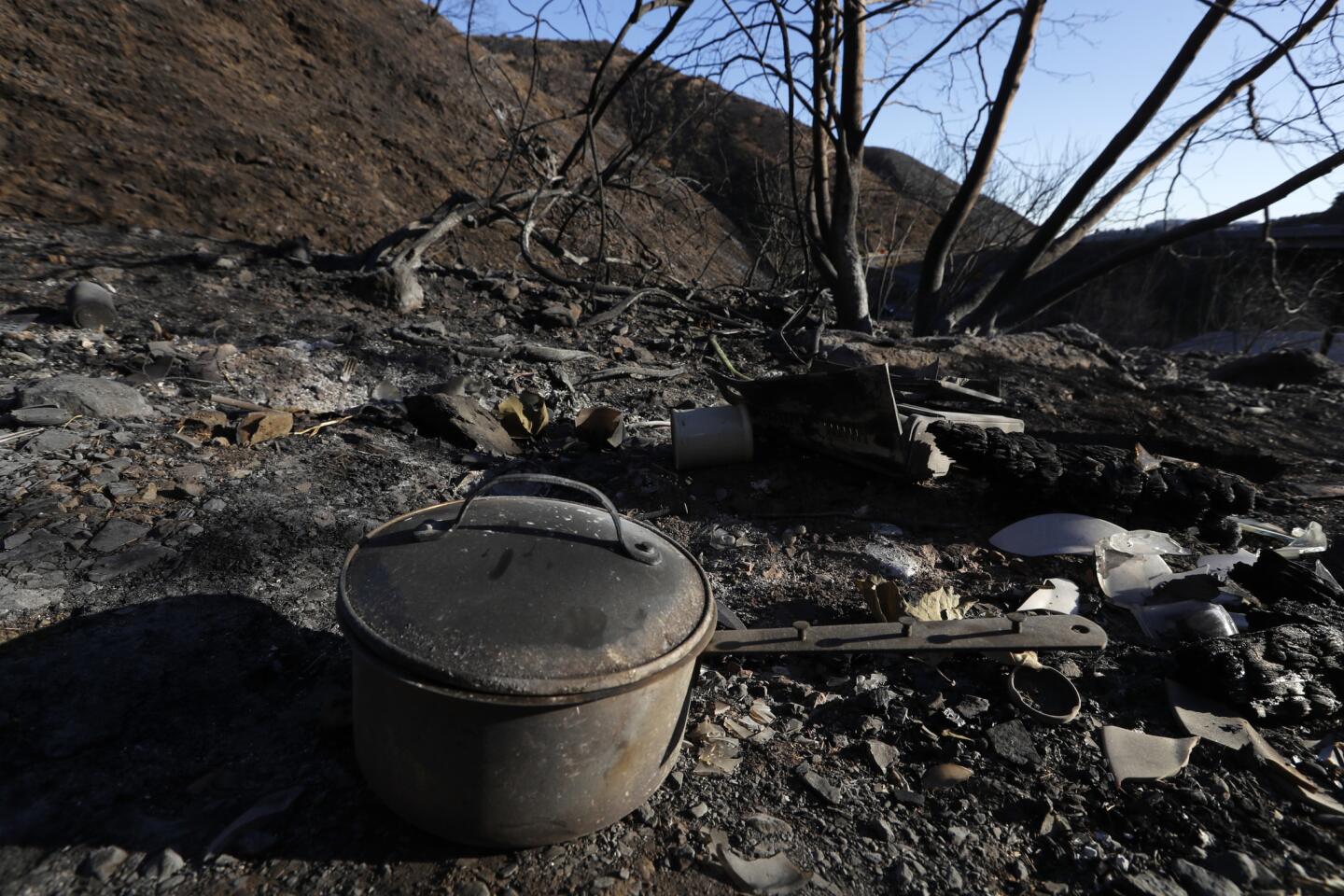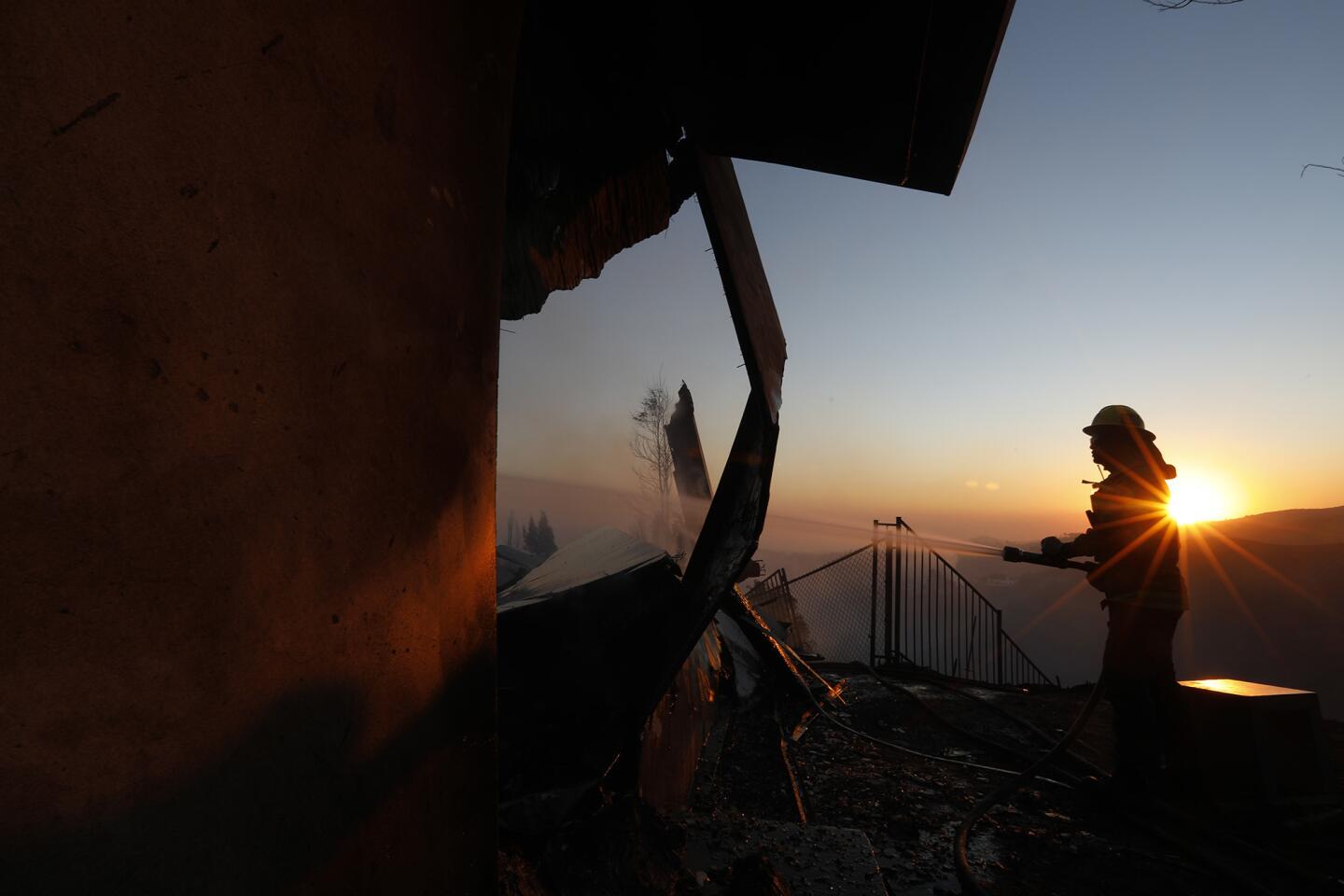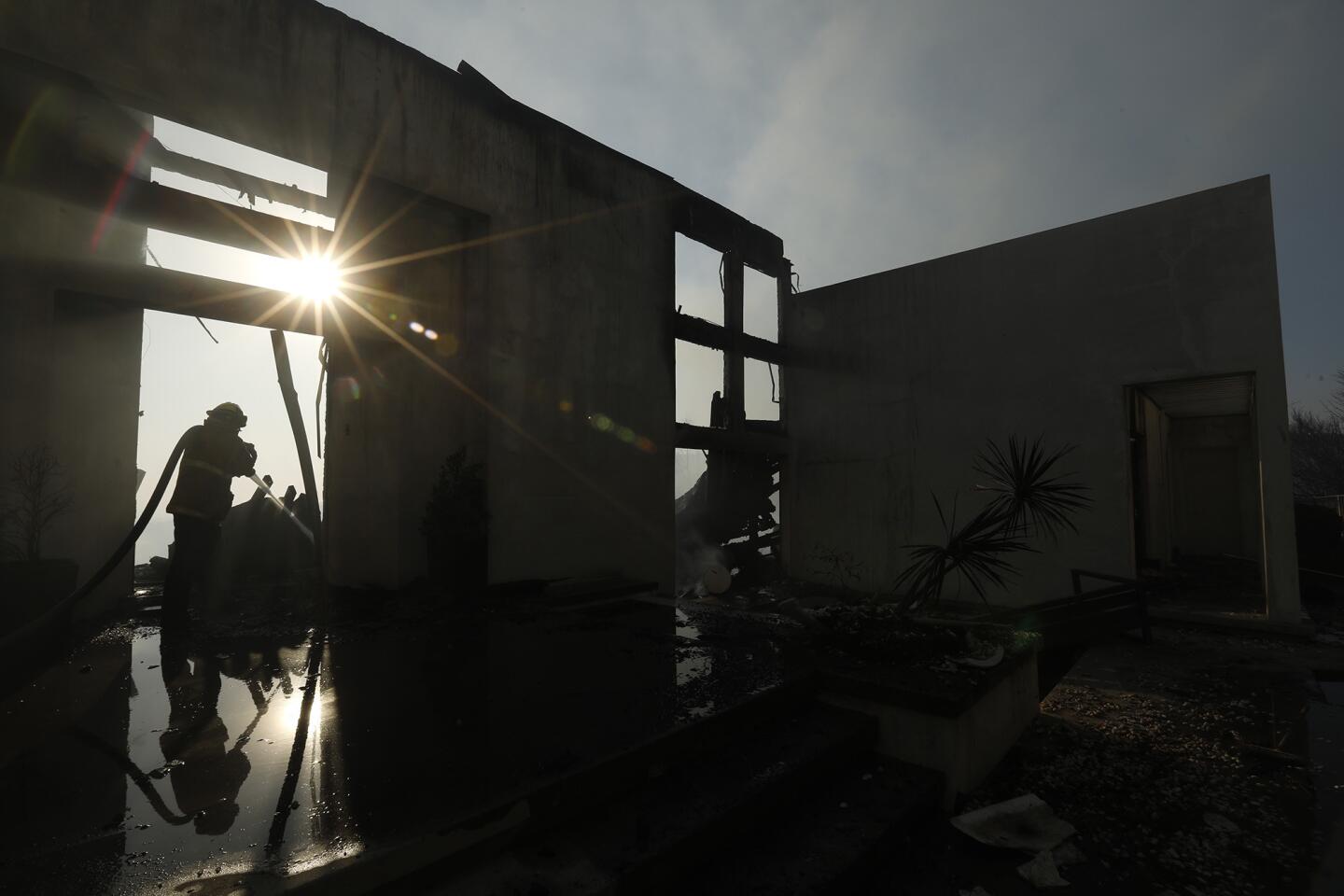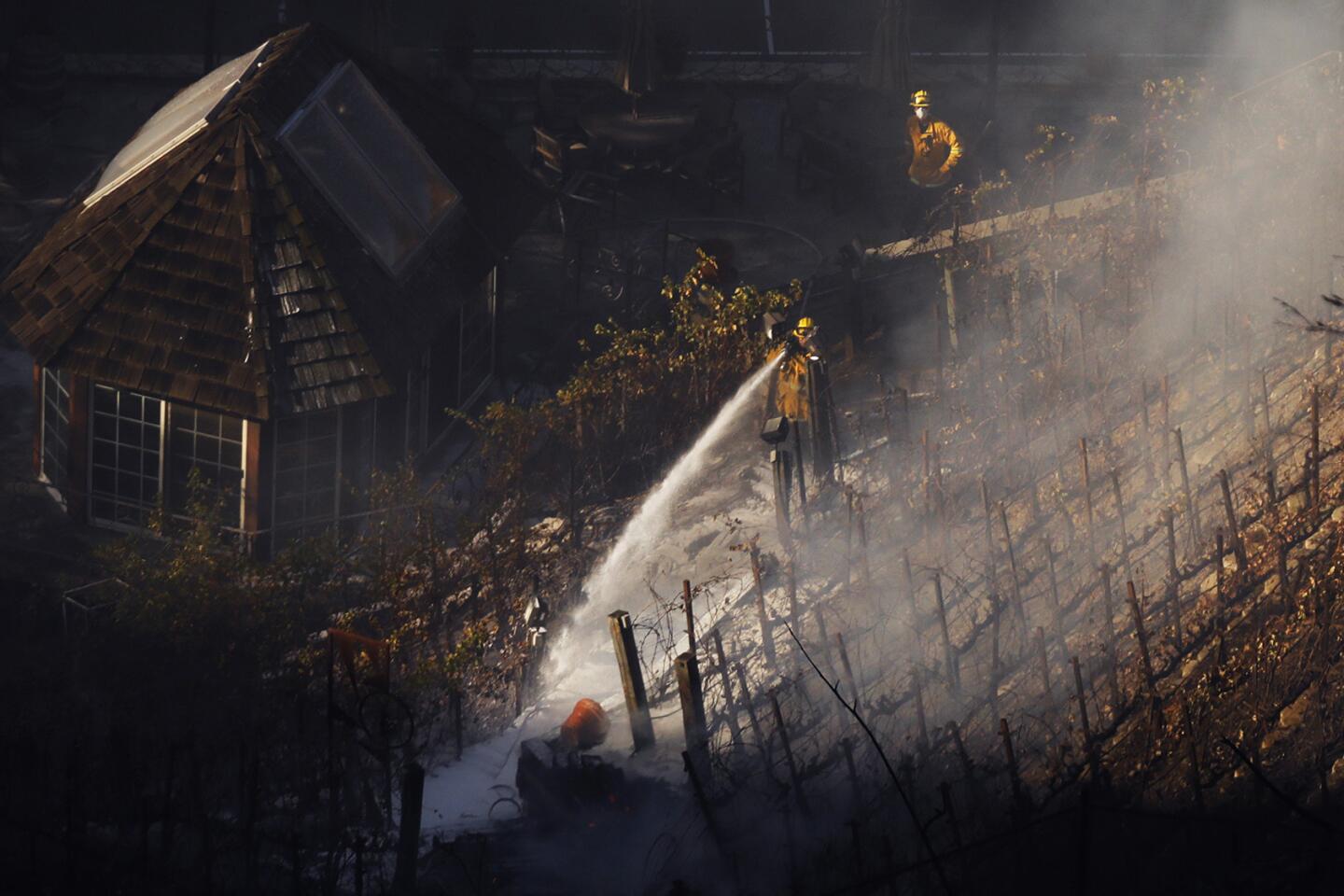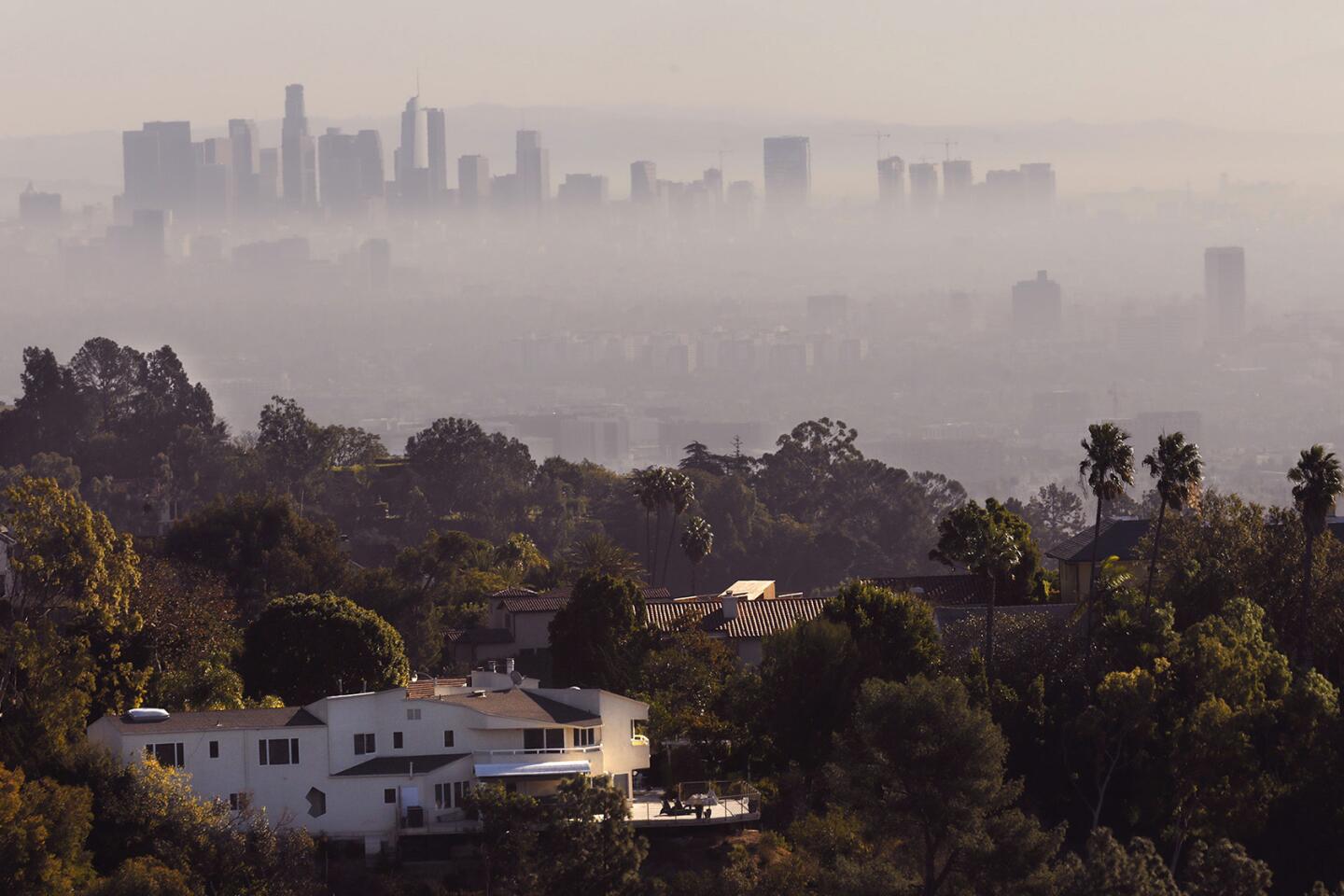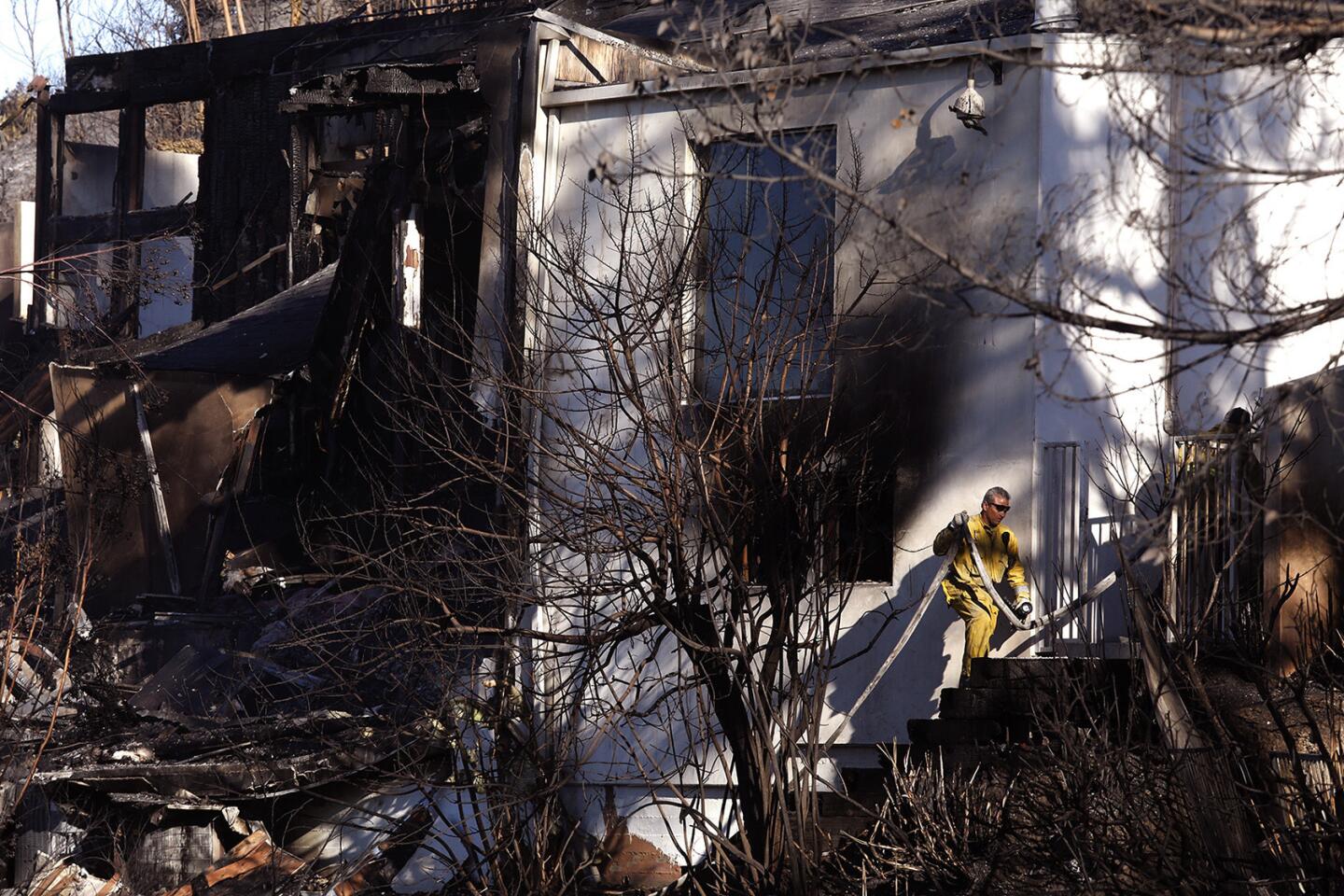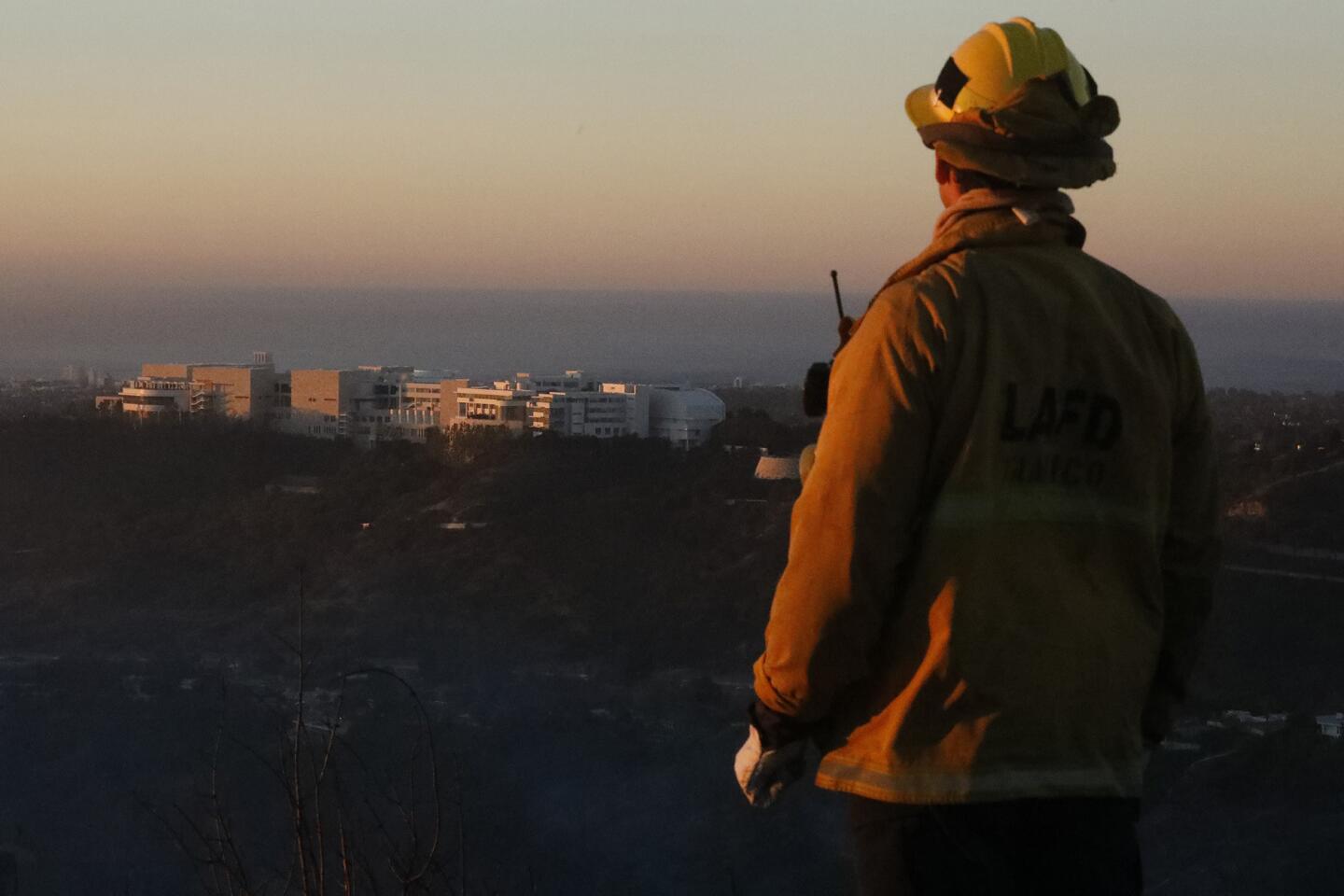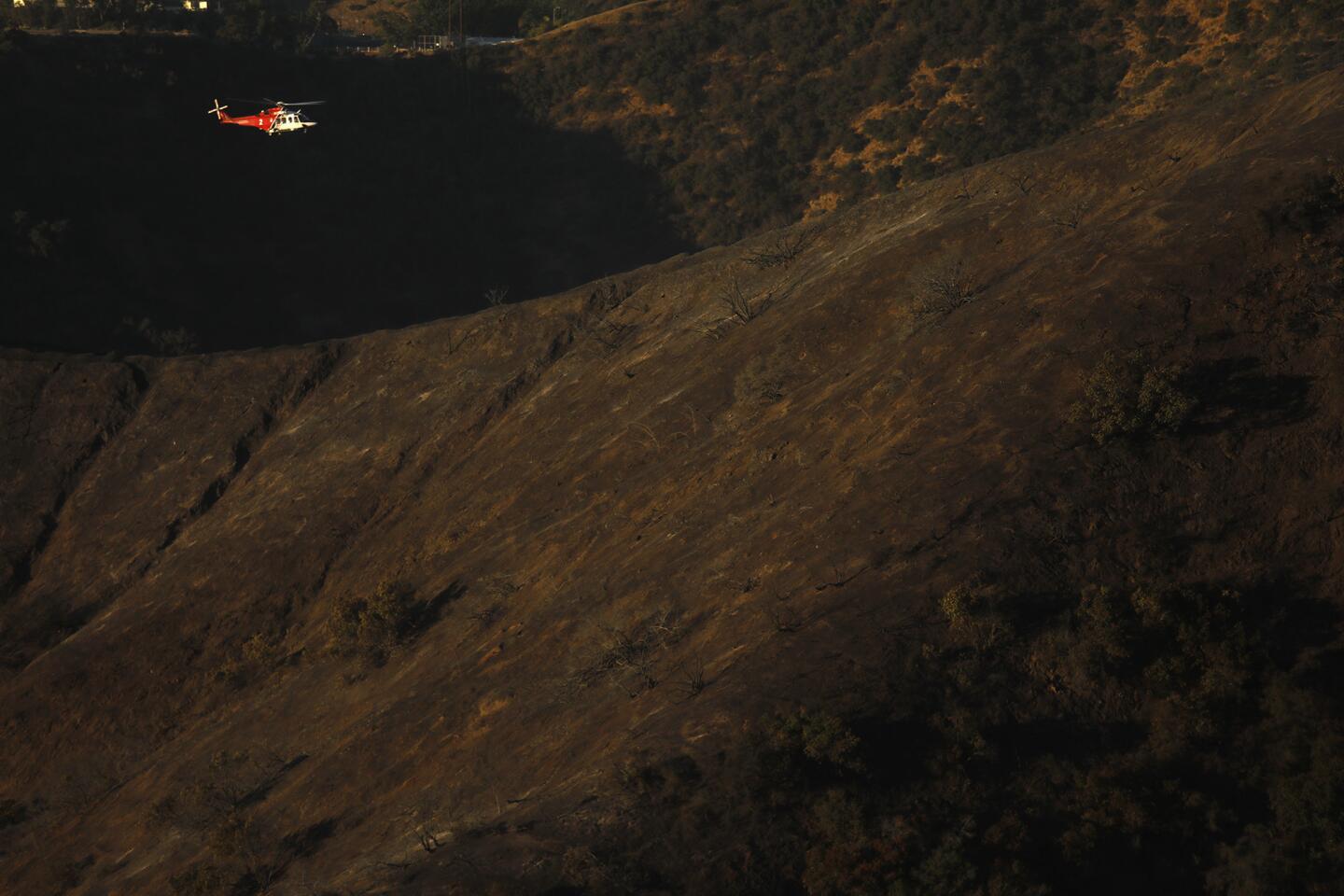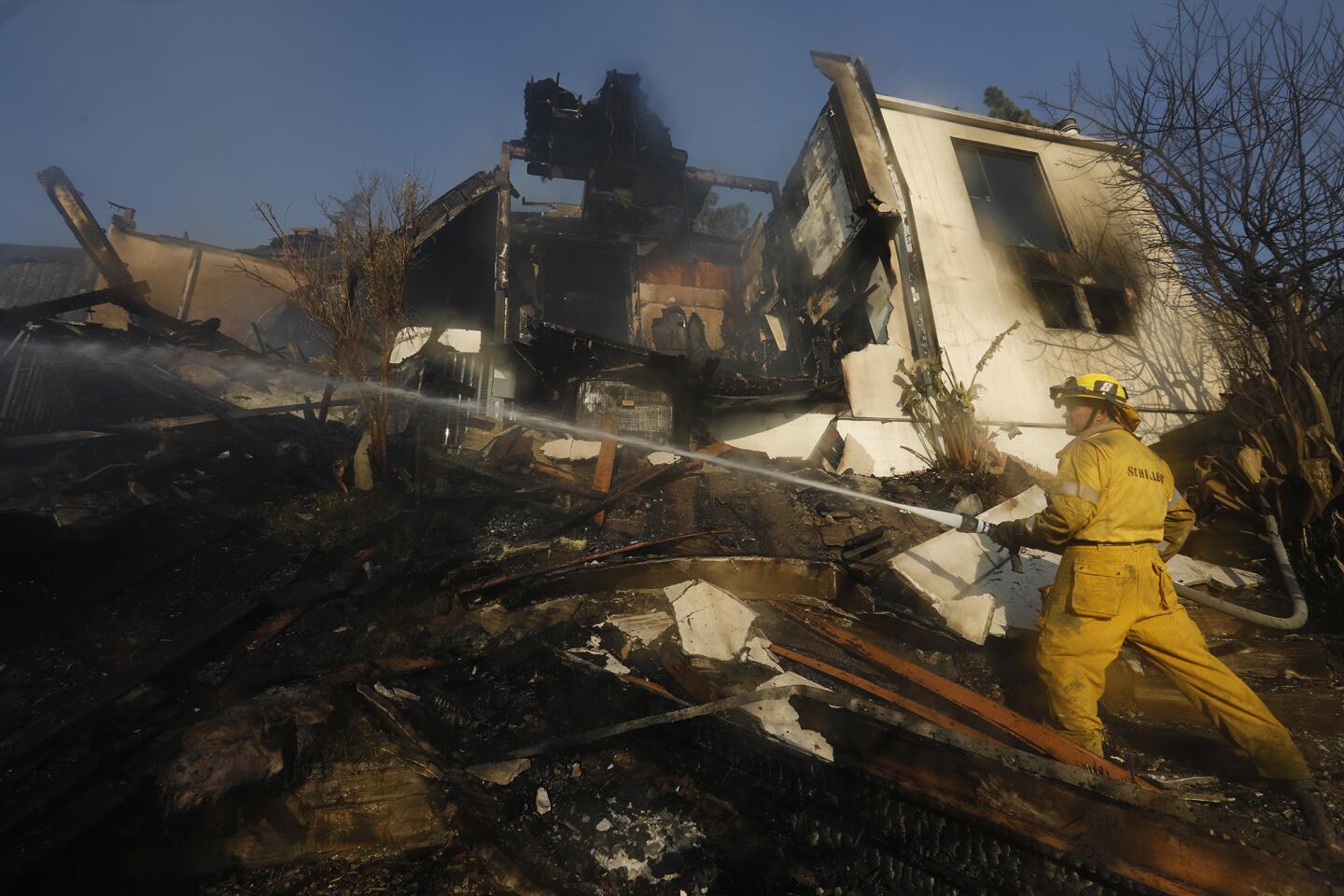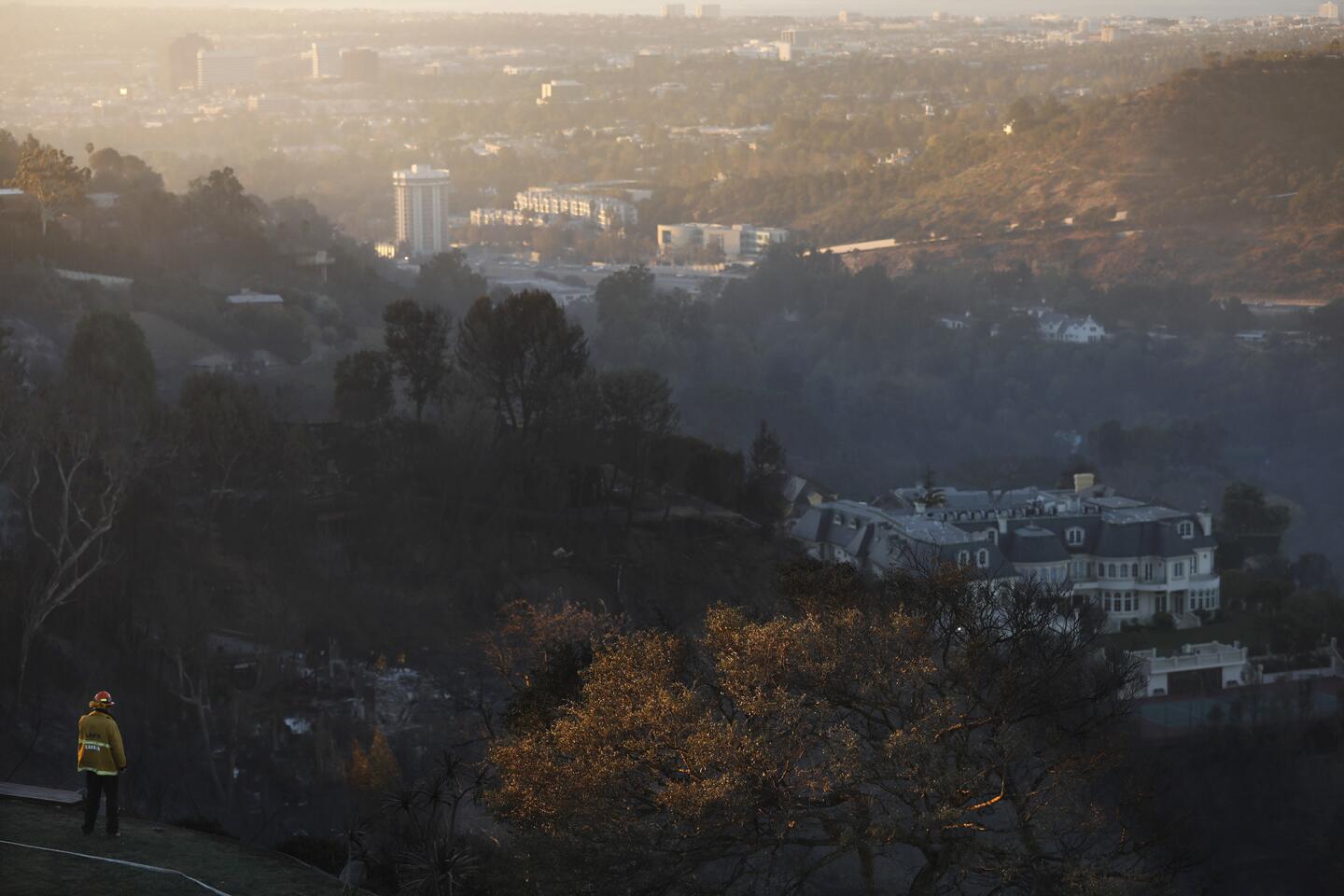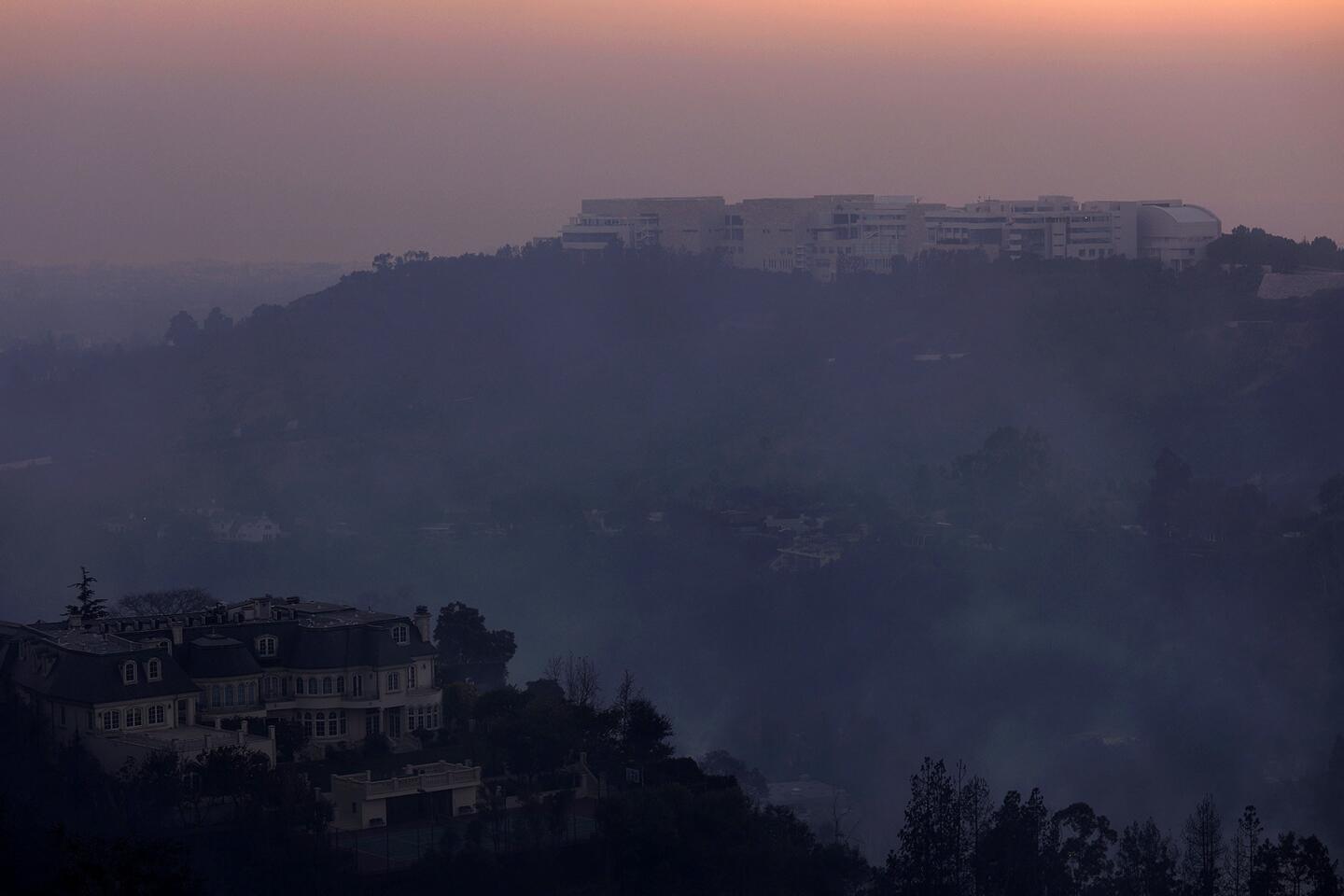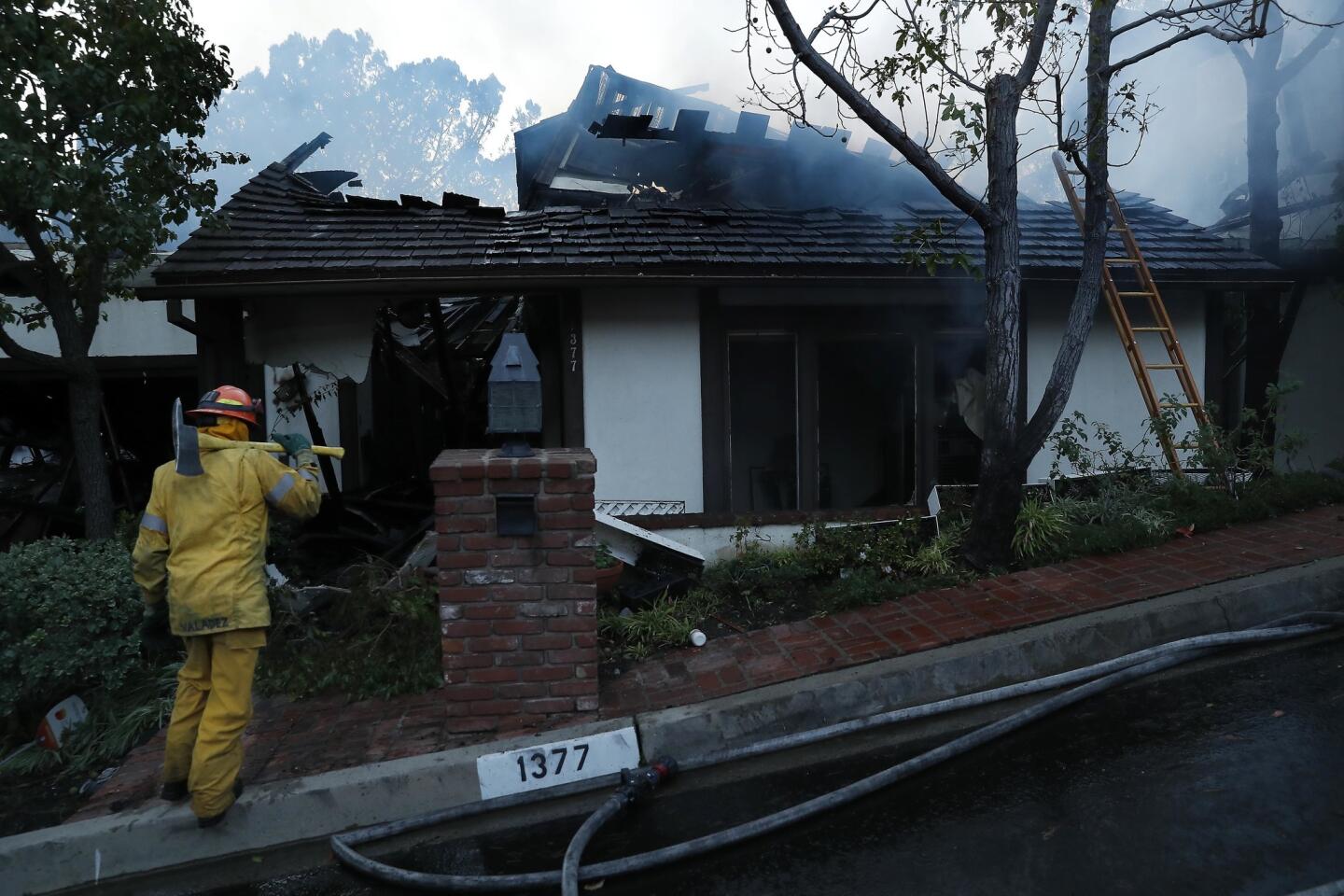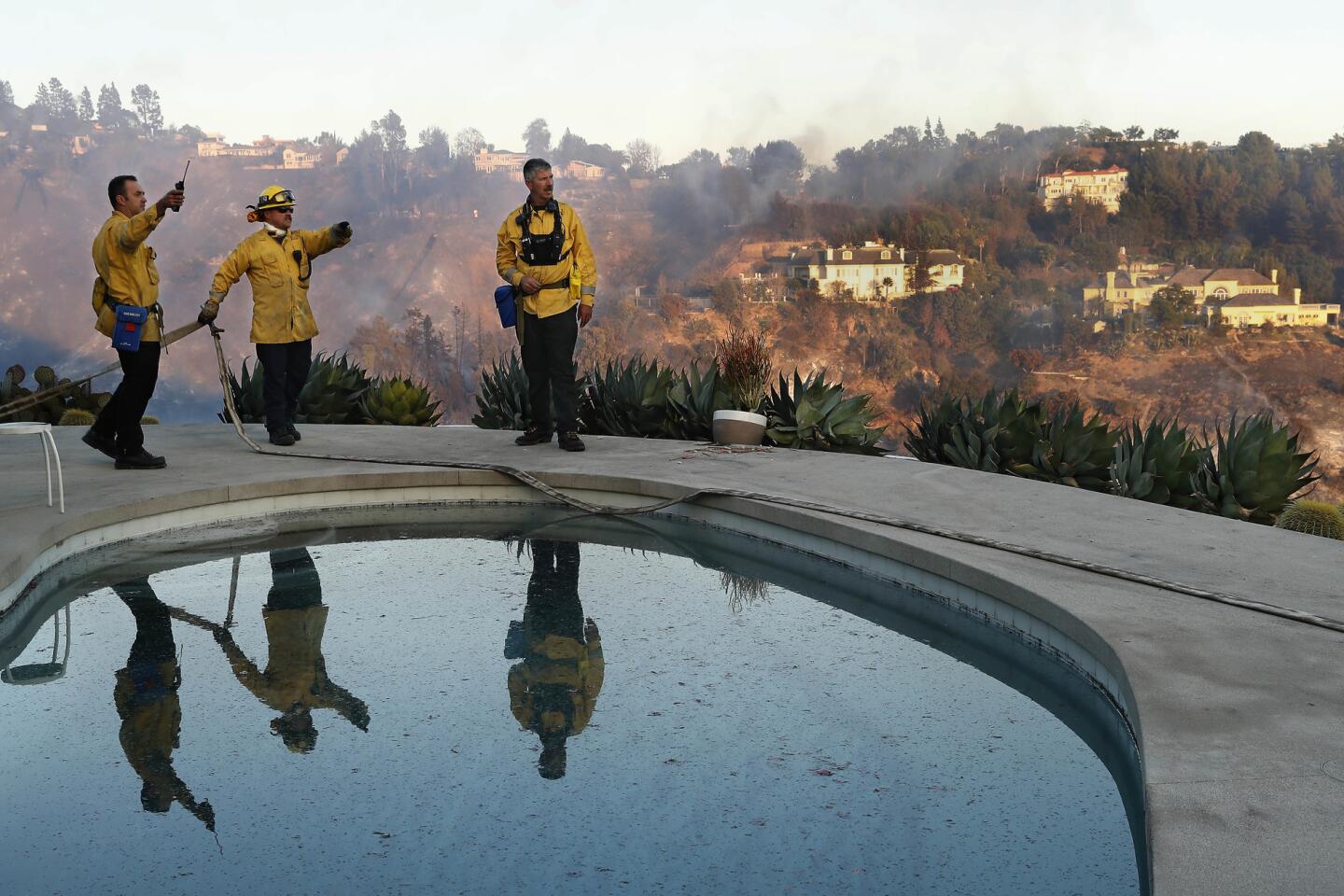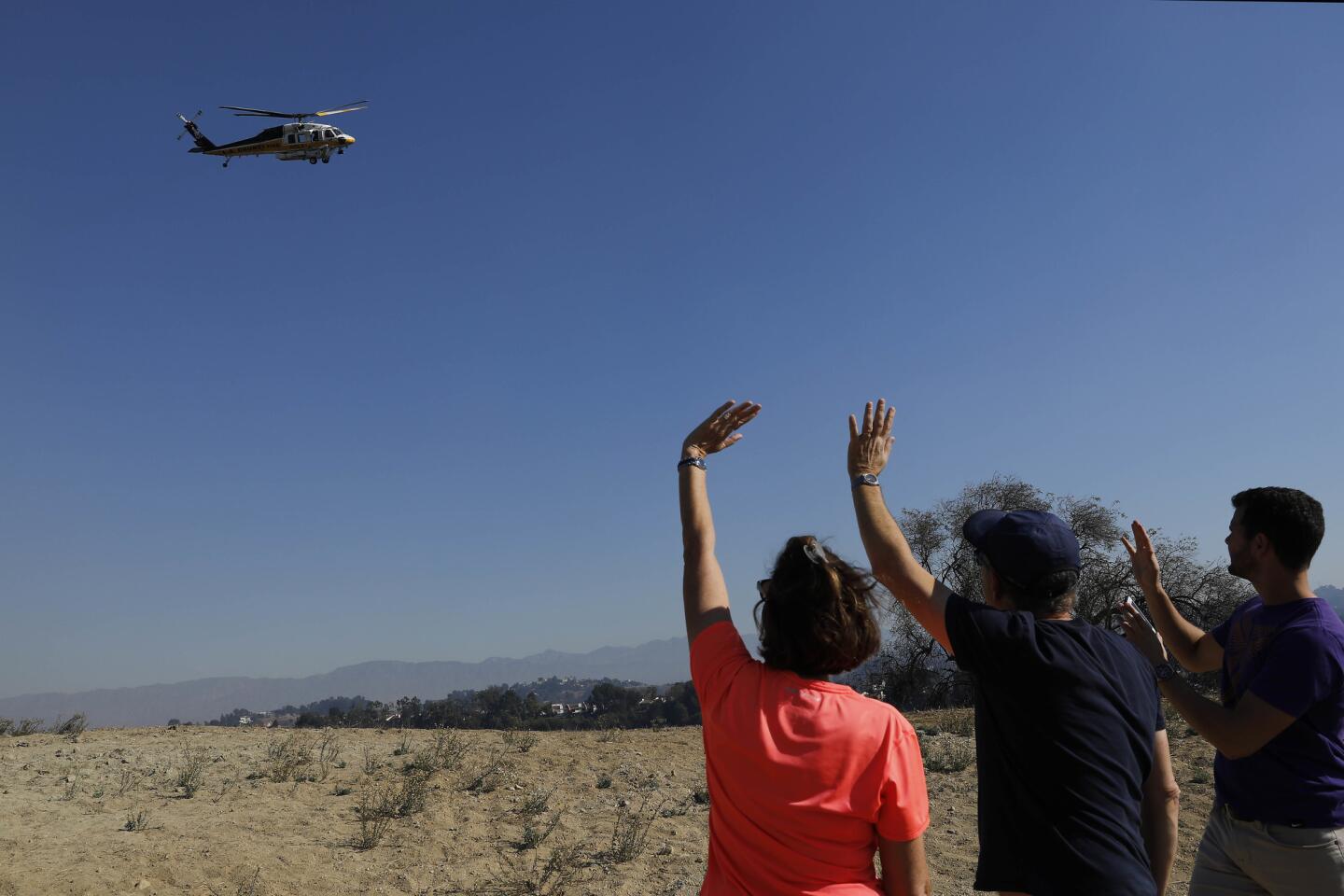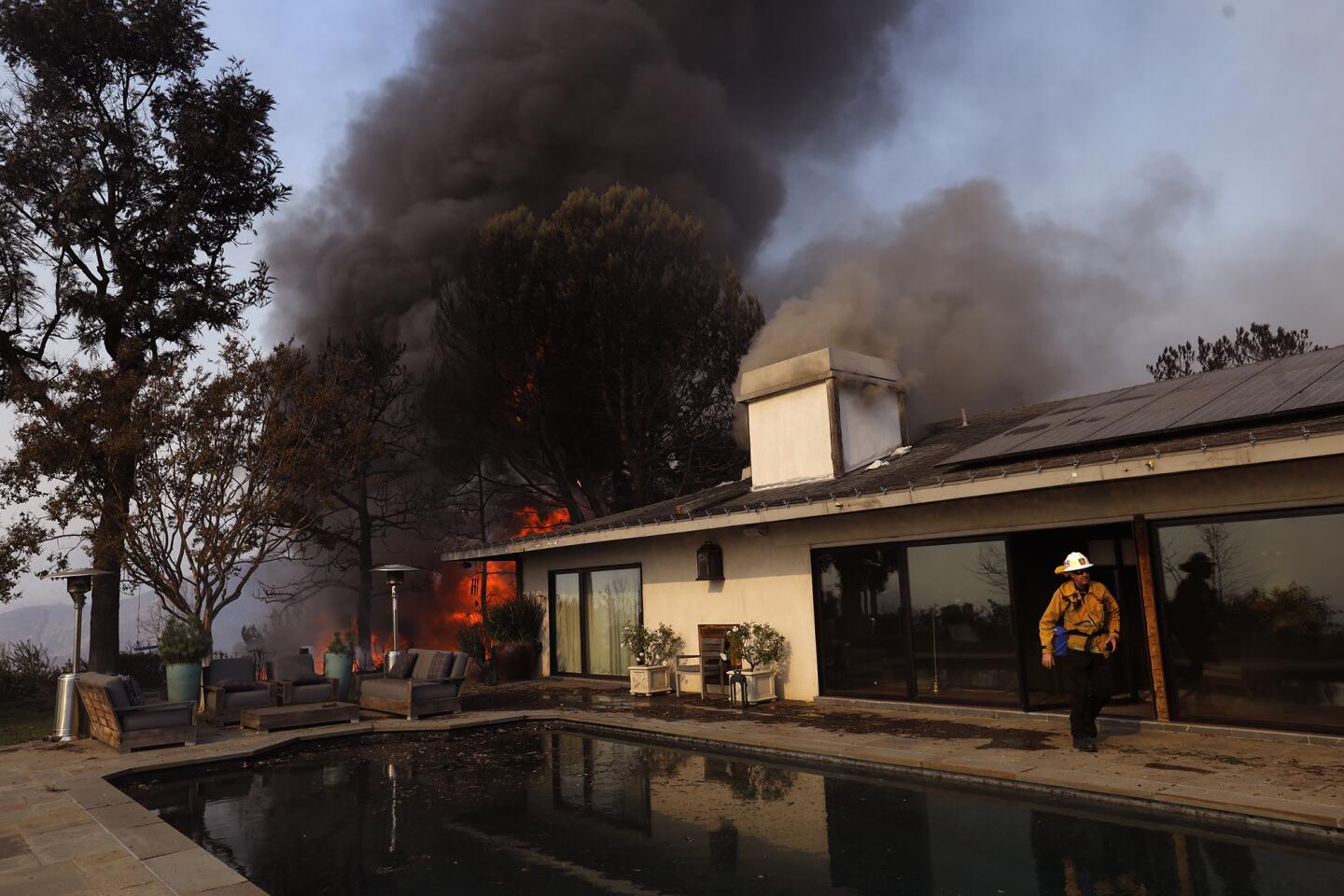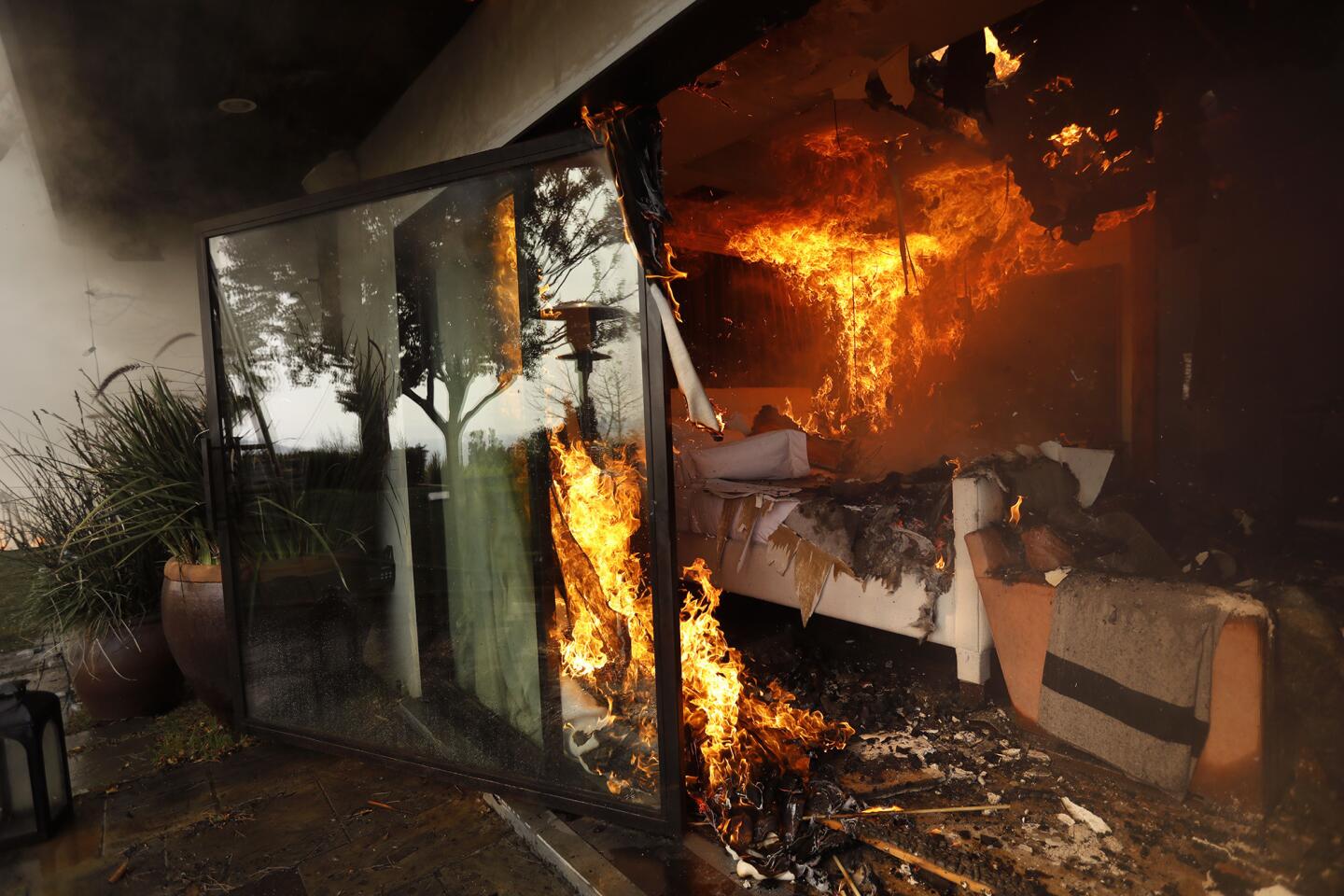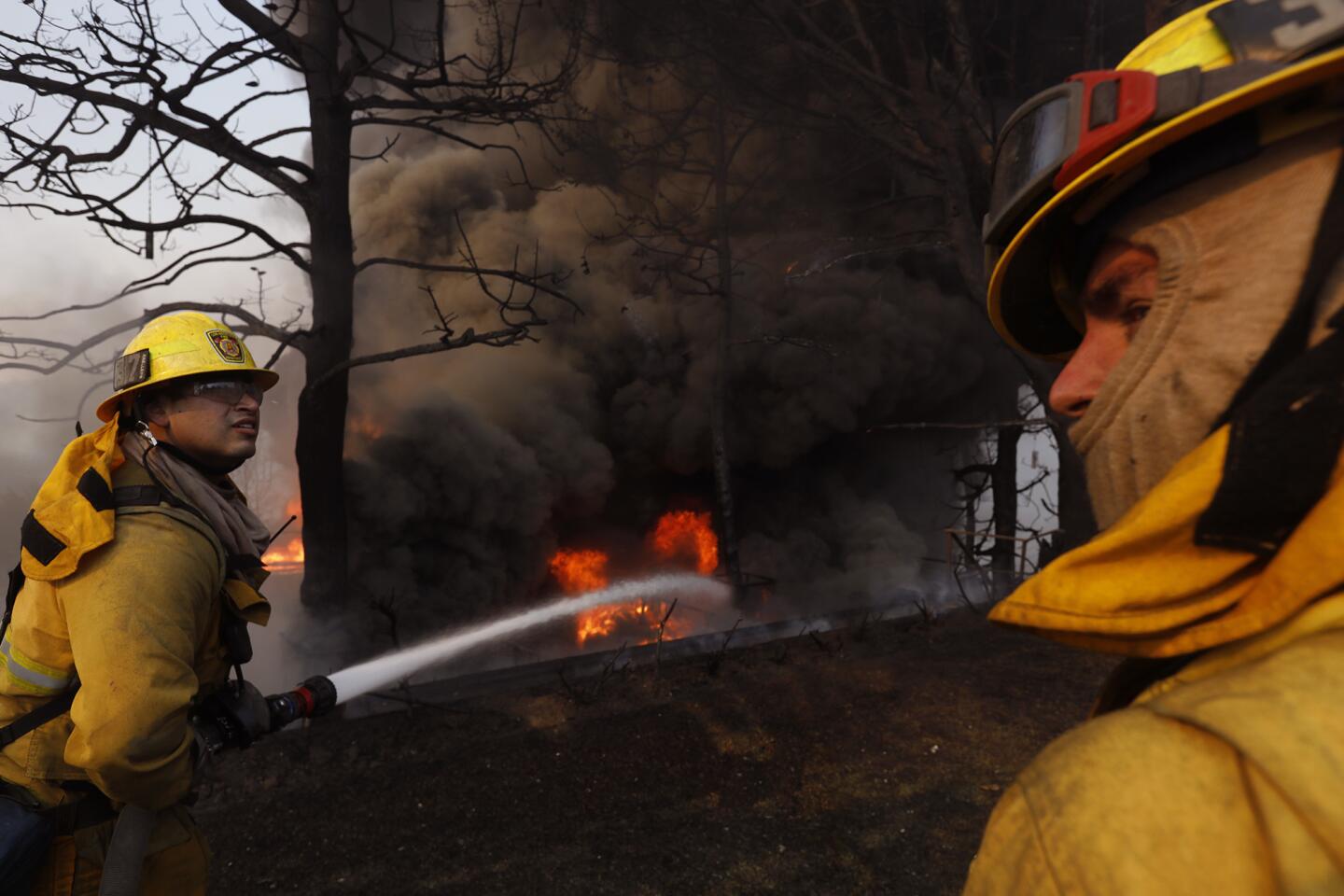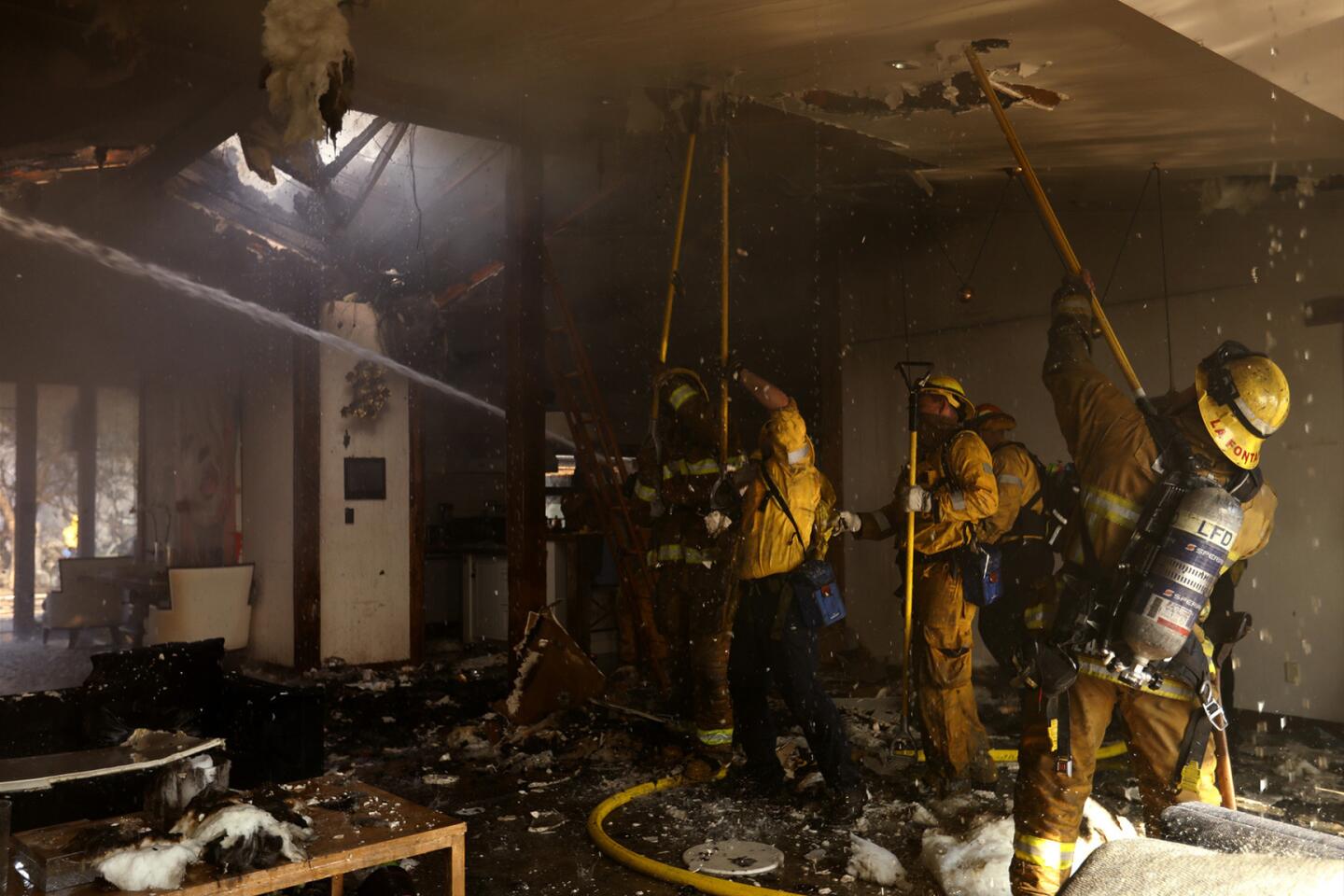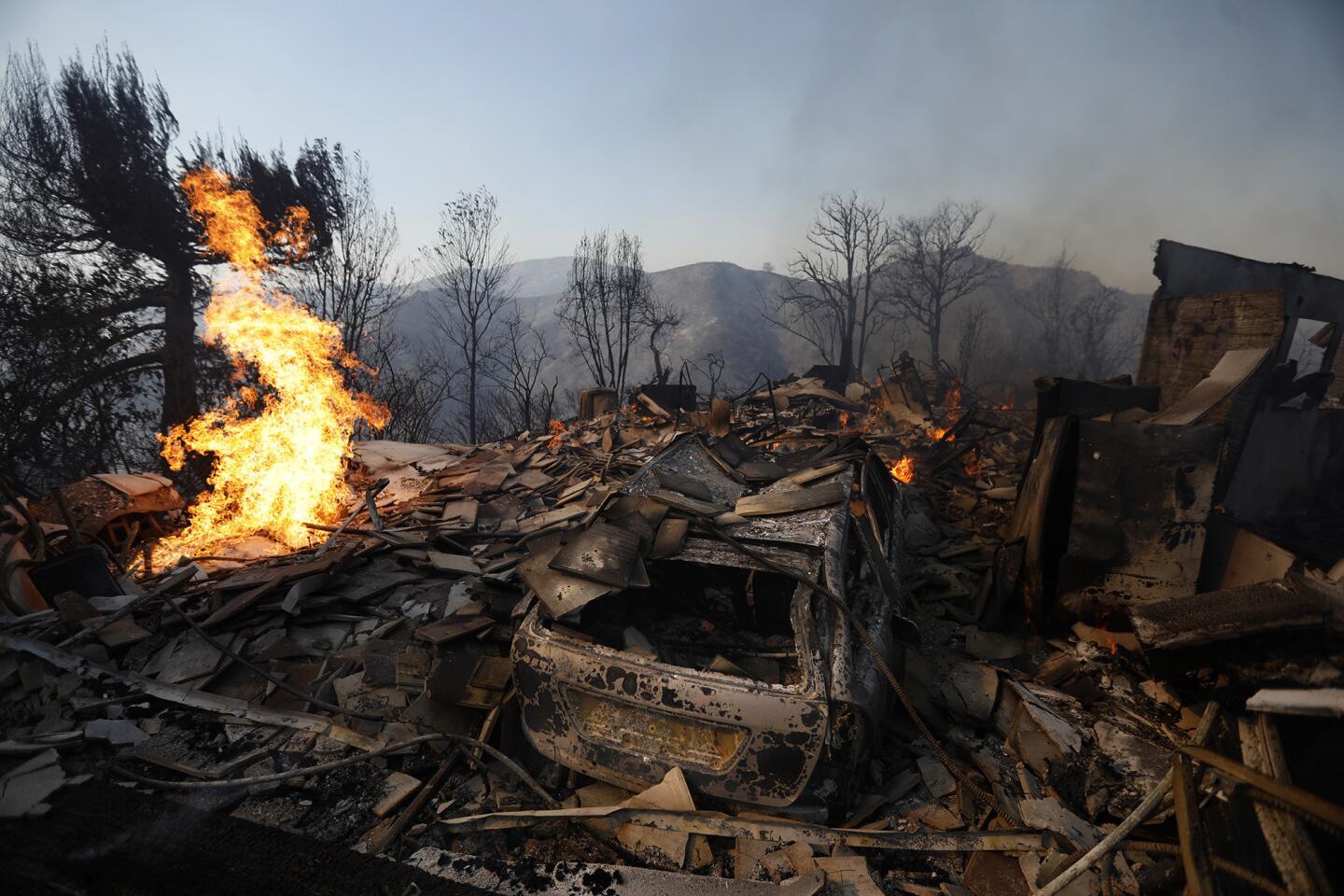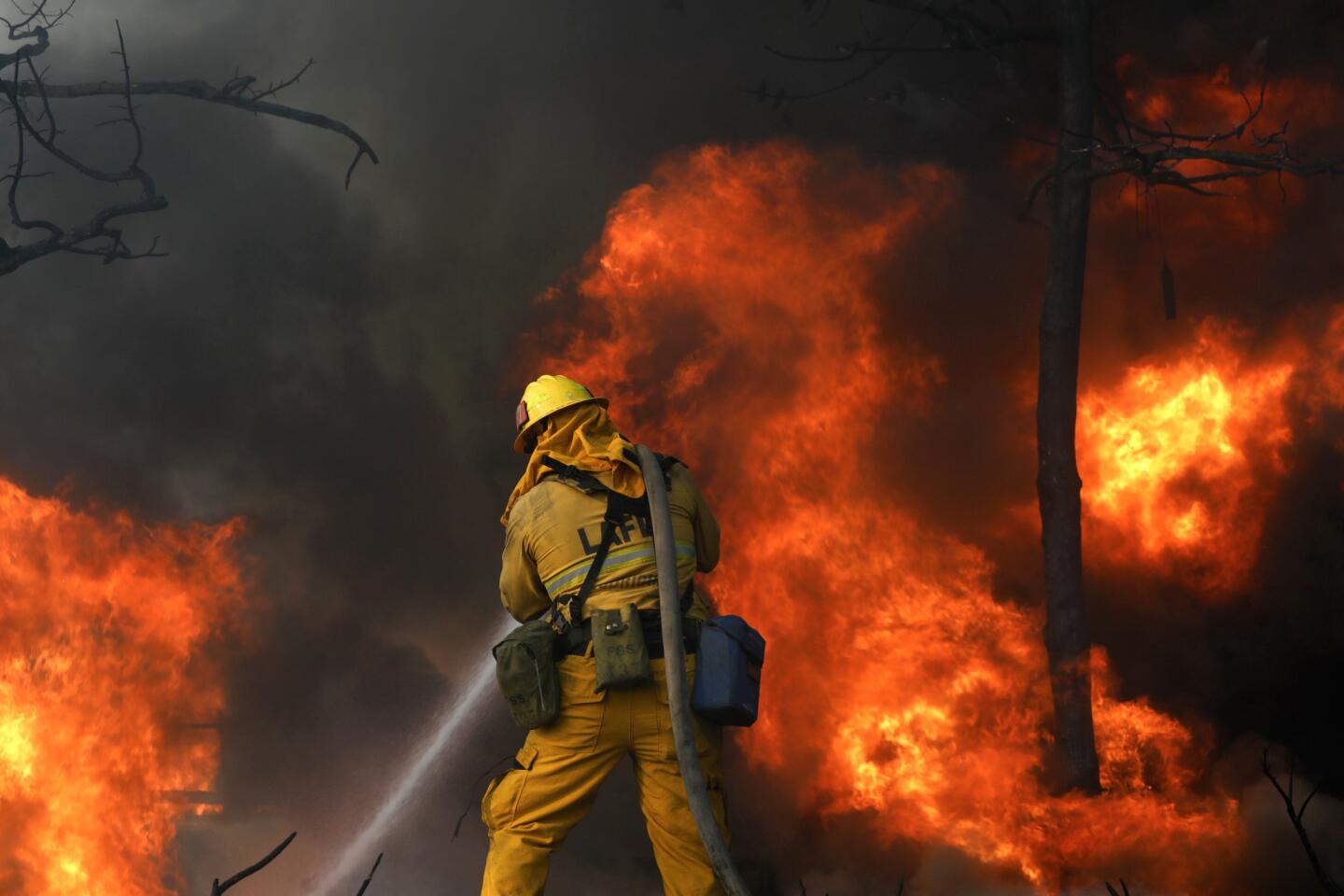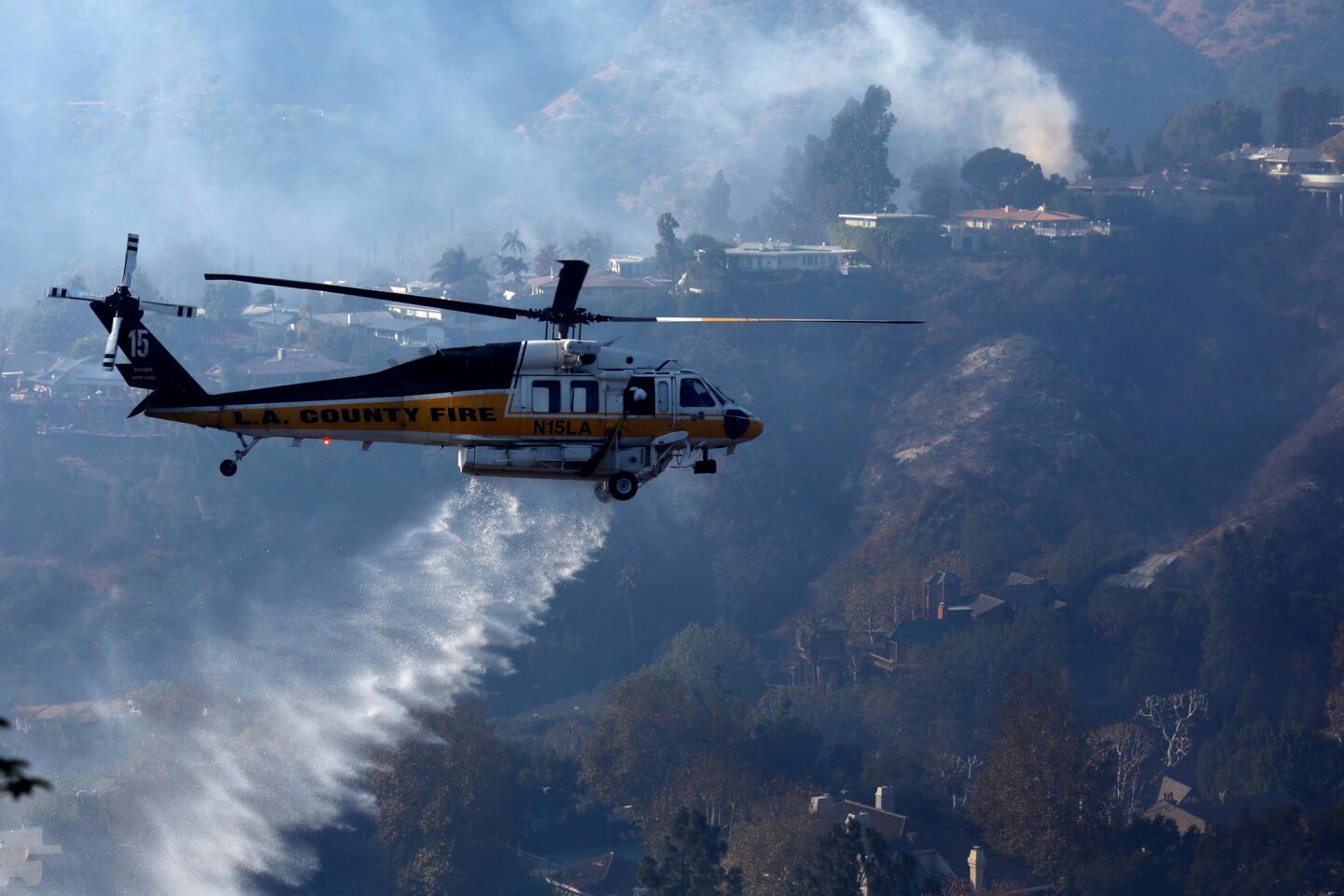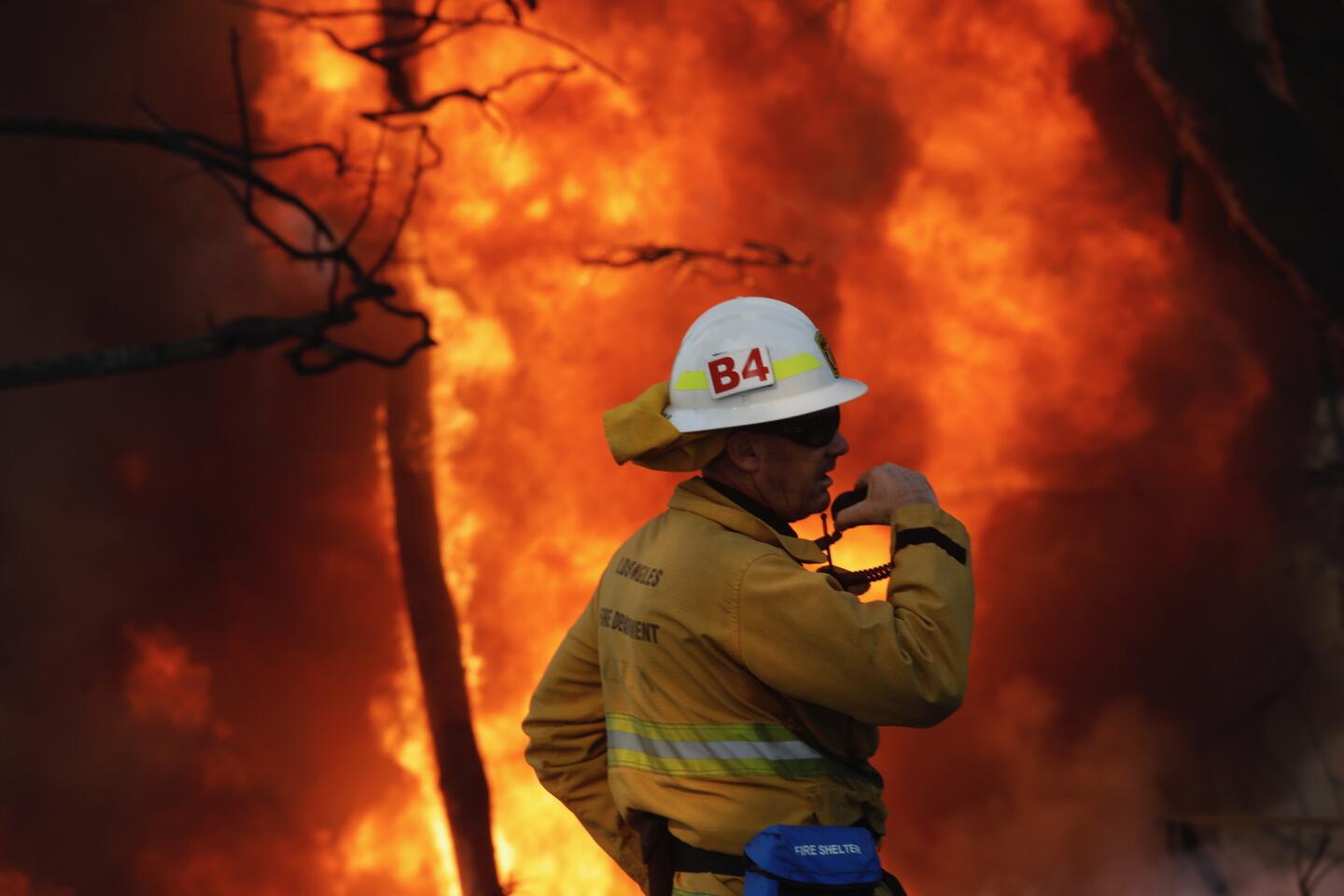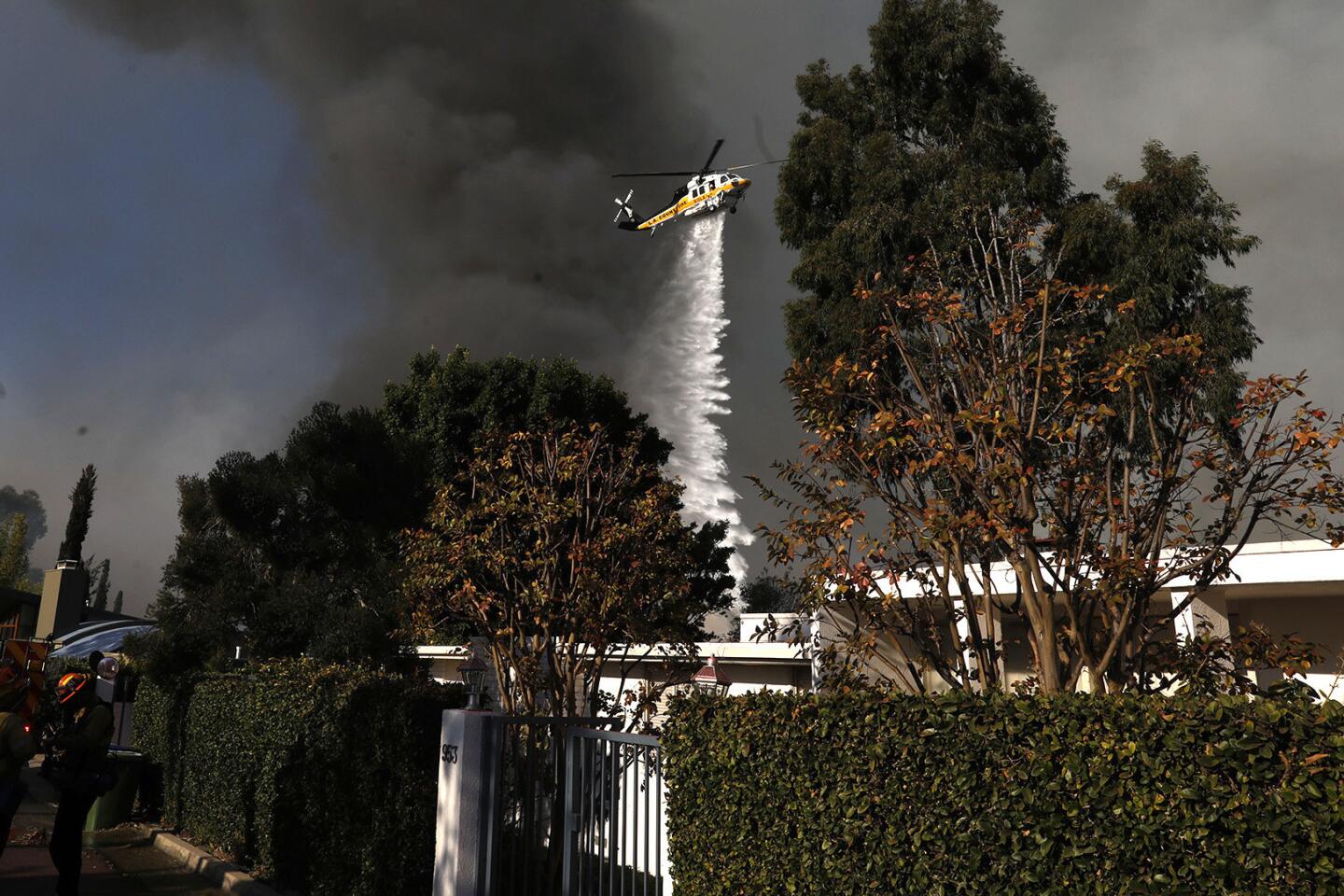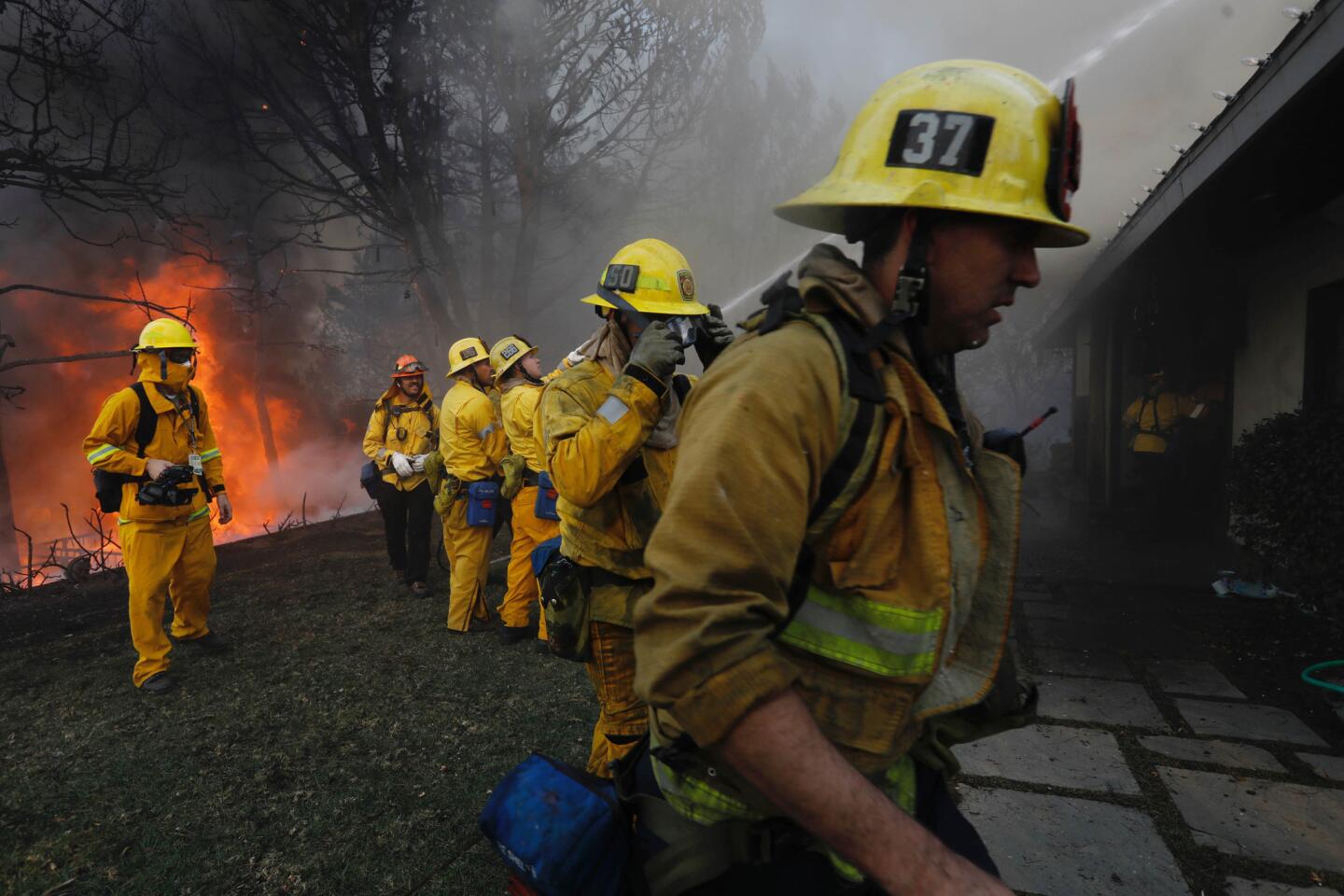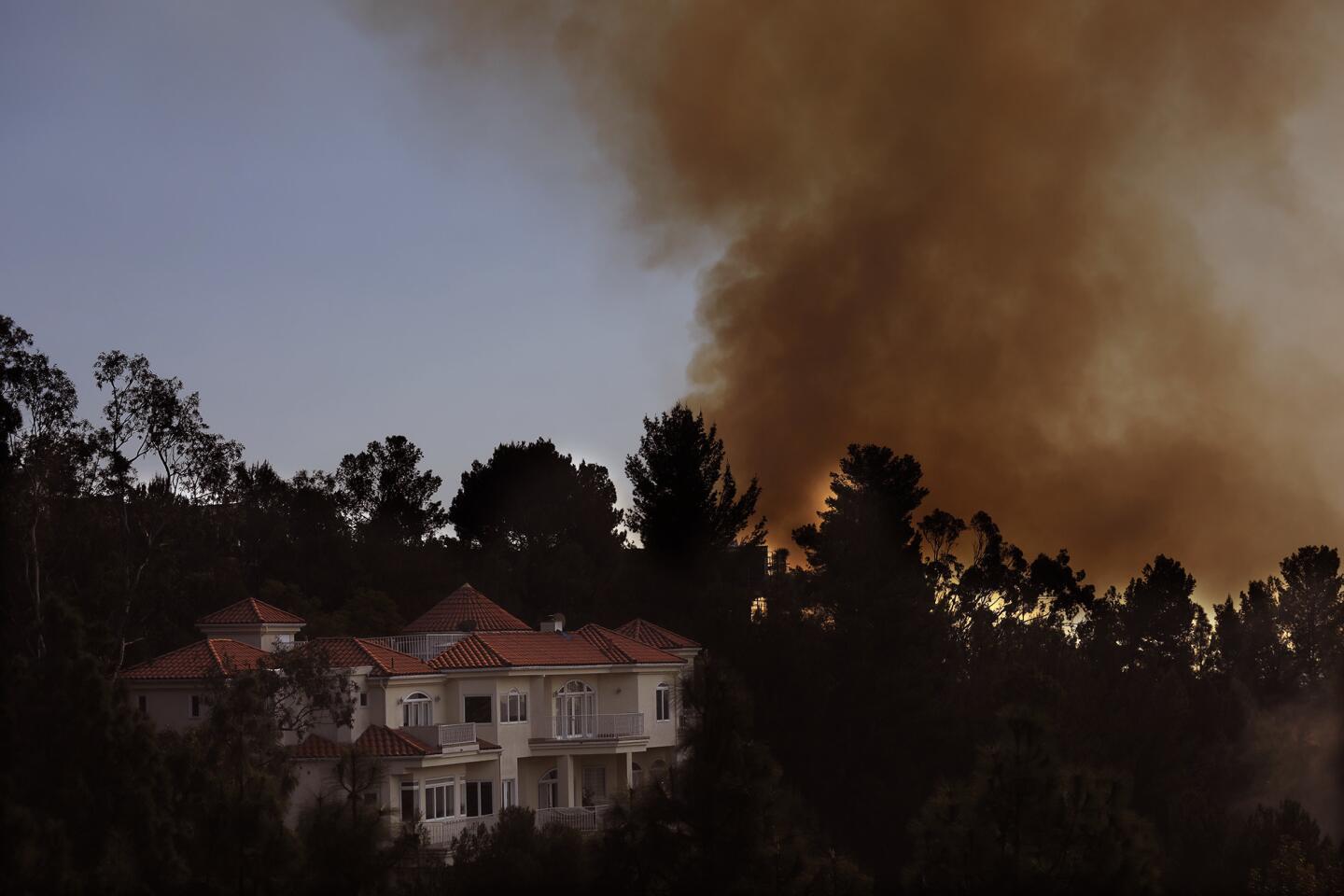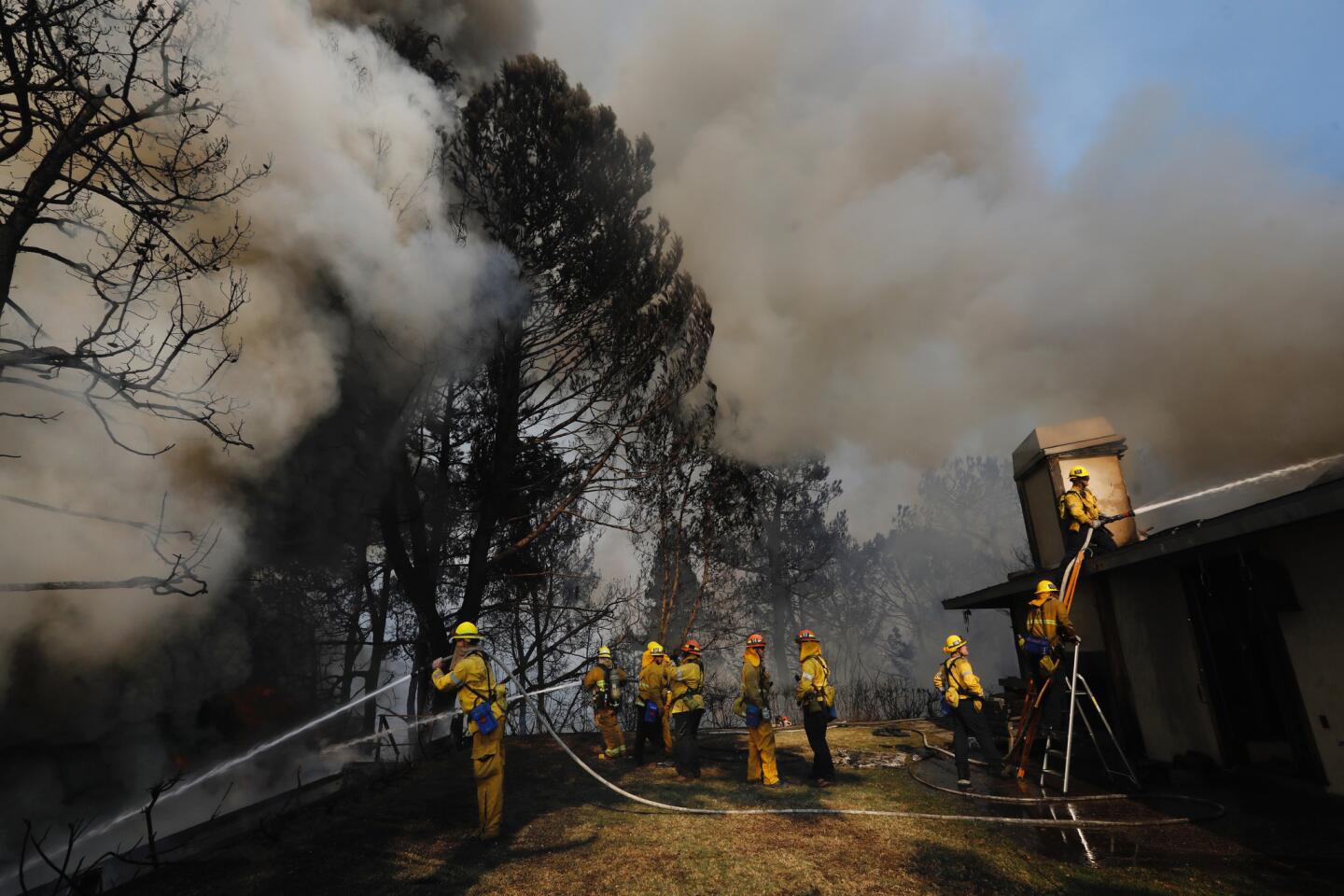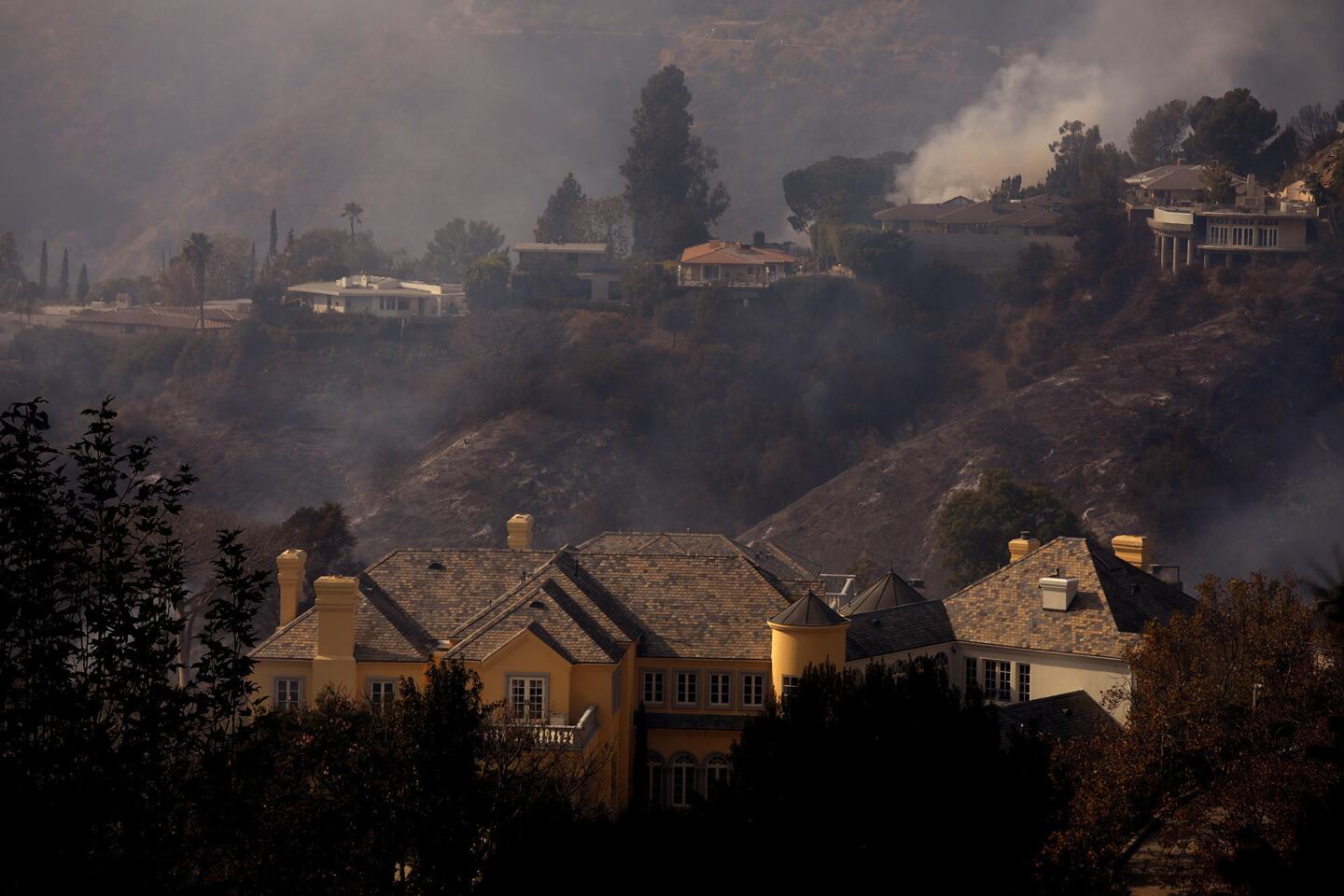During a week of flames, upscale Bel-Air homes burn as fire roars through canyon
- Share via
The fires rampaging across Southern California on Wednesday ripped through a Bel-Air canyon in the hills above UCLA, an elite enclave where backyard tennis courts are the norm and Rupert Murdoch owns a $30-million vineyard estate.
As evening fell, the Skirball fire had scorched 475 acres of thick chaparral, destroying four homes on Moraga Drive at the bottom of the canyon and Casiano Drive on its west ridge. Eleven more houses had been damaged.
For the record:
9:45 a.m. Dec. 7, 2017An earlier version of this story referred to Moraga Canyon as being adjacent to the 405 Freeway closure. It is called Hoag Canyon.
The fire brought back memories of the 1961 Bel-Air fire, in which movie stars including Maureen O’Hara and Fred MacMurray fought to save their homes — a seminal event that fed apocalyptic visions of Los Angeles for decades to come.
Wednesday’s fire drew on another iconic aspect of L.A. life: a soul-crushing traffic jam on the 405 Freeway.
Officials closed the freeway through Sepulveda Canyon, directly west of Hoag Canyon, from just after 5 a.m. until 1:30 p.m. With that artery closed, freeways and streets throughout the city clogged.
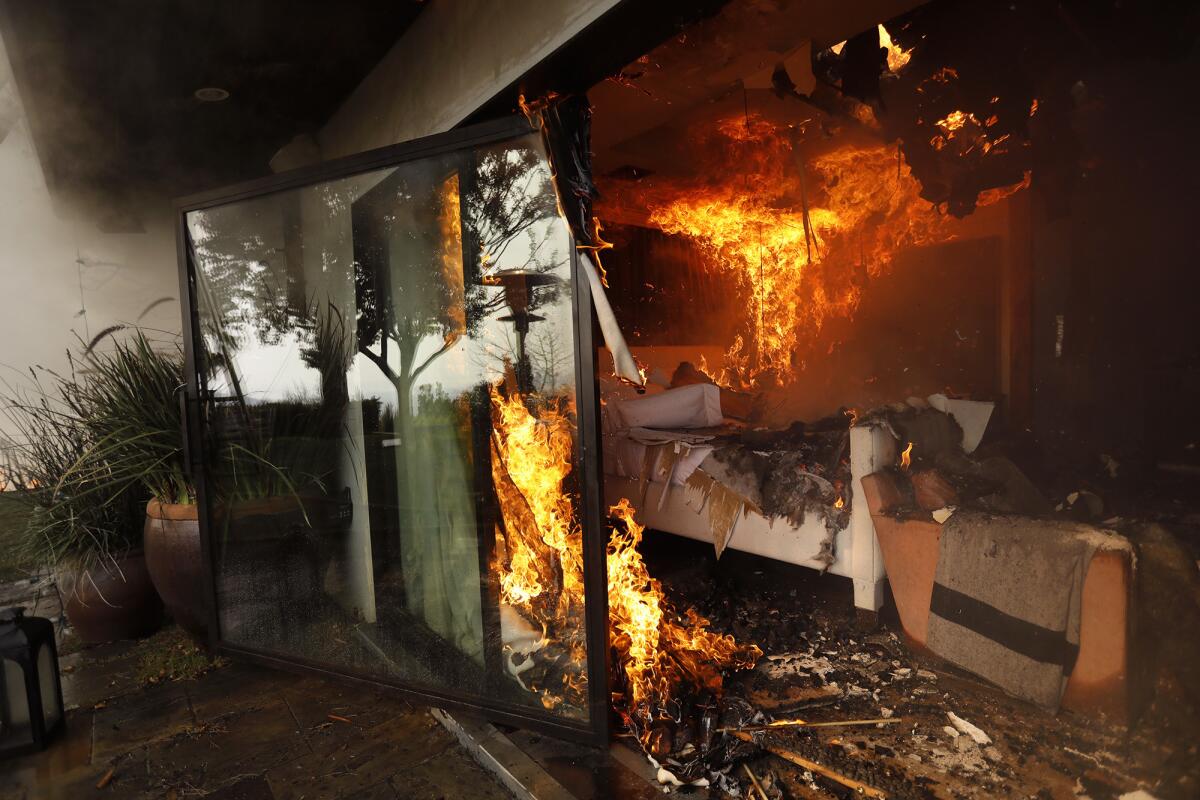
Smoke from the 11,000-acre Creek fire near Sylmar only added to the miserable situation; fires in Santa Clarita and Ventura County also continued to burn through the dry landscape.
In Bel-Air, helicopters chopped through the muck, dropping water on the ridges at the optimal “50/50” — flying 50 feet above the flames at 50 mph.
More than 350 firefighters, 52 engines and six fixed-wing aircraft also were fighting to keep the fire in the heart of the canyon, away from homes.
Just to the south, UCLA canceled classes and told faculty and staff who were off campus to stay away. The university lost power, as did more than 800 Department of Water and Power customers.
Jackson Rogow, 24, woke up at 6 a.m. to the smell of smoke and the wail of sirens. In his boxer shorts, he ran out to the sidewalk on Bellagio Road — where, 56 years before, Zsa Zsa Gabor lost her house, saying: “My three dark minks, my white mink, my sables, some really very nice little jewels are gone.”
His neighbors were already in the street, packing their cars. The waning crescent moon was blood red.
Rogow turned on the news and in the aerial footage of the fire saw his eight-unit apartment building in the apparent path. “We should pack,” he told his girlfriend.
By 7 a.m., fire trucks were racing up and down the street. He waved to one and shouted, “Should I leave?” A firefighter gave him a thumbs up, he said.
Rogow packed the couple’s cat, Zeppelin, and a bag of kitty litter. His girlfriend found a stack of photographs of her late father.
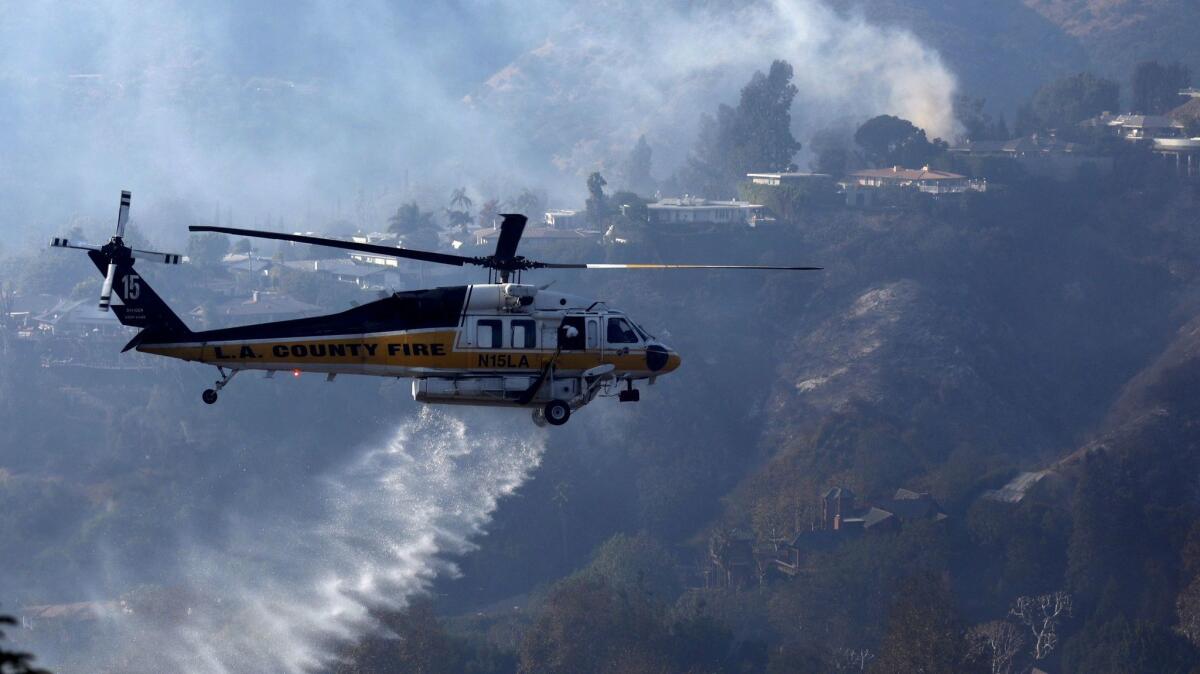
About 8:30 a.m., he got an emergency alert on his phone advising him of the evacuation area boundaries: the 405 Freeway on the west, Sunset Boulevard to the south, Roscomare Road to the east and Mulholland Drive to the north. They were squarely inside it.
Rogow remembered a conversation he’d had with his neighbor, who had temporarily left the state for cancer treatment. When she left, Rogow had asked her a question arguably unique to Southern California canyons: “If your house is burning down, what do I grab?”
Her medals, she said. She had more than three dozen — from marathons, half-marathons and 5K races. Rogow broke a window and grabbed them.
Rogow planned to go to a friend’s apartment in Westwood with a rooftop where they could watch the fire. But he made one stop first.
“I needed a smoothie,” he said. He picked up his regular order: a blend with probiotics, strawberries and kale.
Residents near Bel Terrace and North Sepulveda Boulevard raced outside as flames encroached on their homes.
Beverly Freeman, 83, pulled out of her driveway ahead of the fire just before 7 a.m. She didn’t take any belongings with her.
As Freeman drove away from the two-story gray house that her husband built for her three decades ago, she was not sure whether she would have a home to return to.

“I was going to die in this house,” she said as tears came to her eyes. “The flames have never come so close.”
The 405 closure jammed many roads in and around the evacuation zone, making for a nerve-wracking, slow-motion escape.
“It’s getting all jammed up in there,” said LAPD spokesman Josh Rubenstein. “They’re deep into the evacuation area.”
Up Hoag Canyon around 1:30 p.m., an L.A. County firefighter spotted flames in a portion of the 13-acre Moraga Vineyards, which Murdoch bought in 2013. He radioed other firefighters, who within minutes showed up and pried open the gate at the bottom of the property.
When winds picked up again, the vineyard — covering an area from the canyon floor to the eastern ridge — was a big target. Although the vines in October’s fires in Northern California’s wine country mostly survived, winery buildings did not fare as well.
“It’s coming,” said Don Batiste, an engineer with the Los Angeles Fire Department.
Scanning the terrain, he and the others determined it would easier to fight from the air or the ridge.
Three helicopters dropped water on the hot spot, as smoke continued to spiral into the air.

Murdoch released a statement Wednesday saying television footage showed there may be damage to some buildings in the upper vineyard area, but the house and the winery appeared to be intact.
“The situation at Moraga Bel Air is very fluid at the moment,” he said in the statement. “We are monitoring the situation as closely as we can and are grateful to the efforts of all the first responders. Some of our neighbors have suffered heavy losses and our thoughts and prayers are with them at this difficult time.”
By the afternoon, the blaze had subsided, but firefighters continued to guard the multimillion-dollar homes. The winds were expected to hit hard again starting about 10 p.m. Wednesday, and the fire was only 5% contained.
On Moraga Drive, a gated community of about 36 homes, one fire truck guarded every three houses, Batiste said. Neighbors said public figures and celebrities such as Jerry West and Magic Johnson have or still lived on the street.
While residents could only wait to see what the night would bring, firefighters employed hand crews and retardant drops to establish a hard line to keep the fire from spreading into Brentwood, as the flames did in 1961, when they destroyed 500 homes in total and consumed 16,000 acres.
“When the winds come up, they’re going to come out of the northeast,” said Los Angeles Fire Deputy Chief Chuck Butler, “and they’re going to want to push the fire across the 405.”
[email protected] | Twitter: @melissaetehad
[email protected] | Twitter: @laura_nelson
[email protected] | Twitter: @joemozingo
More to Read
Sign up for Essential California
The most important California stories and recommendations in your inbox every morning.
You may occasionally receive promotional content from the Los Angeles Times.
